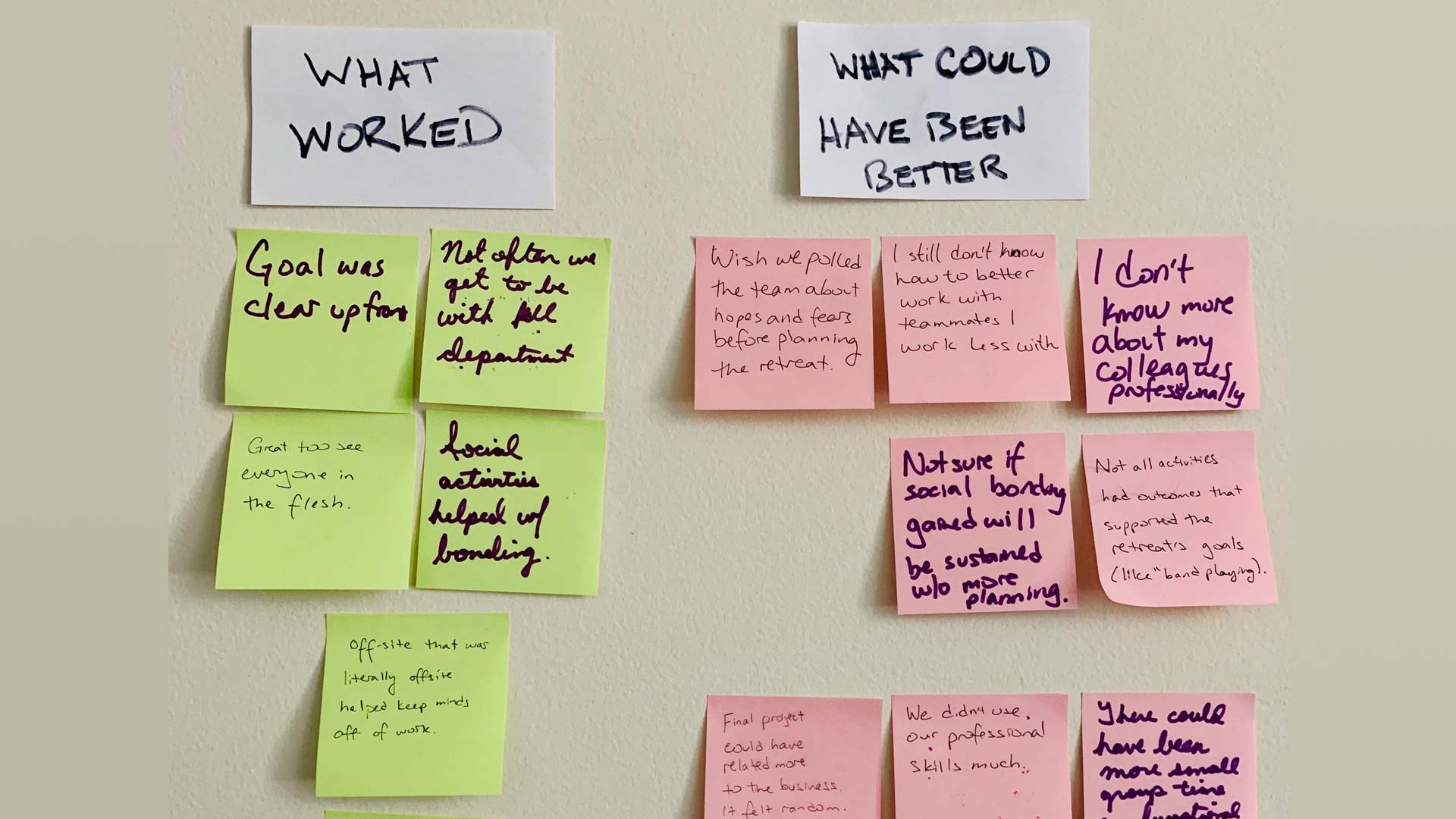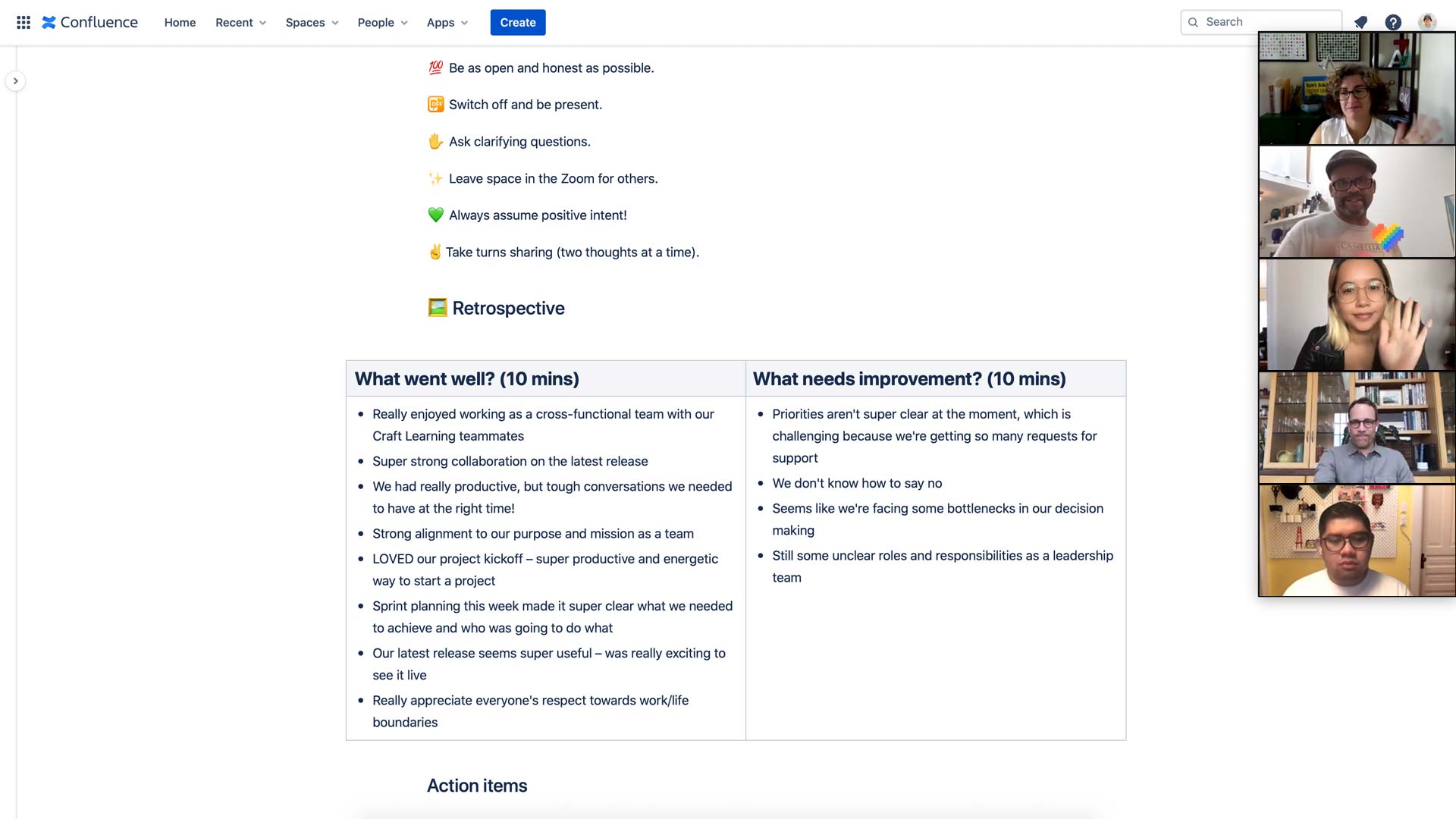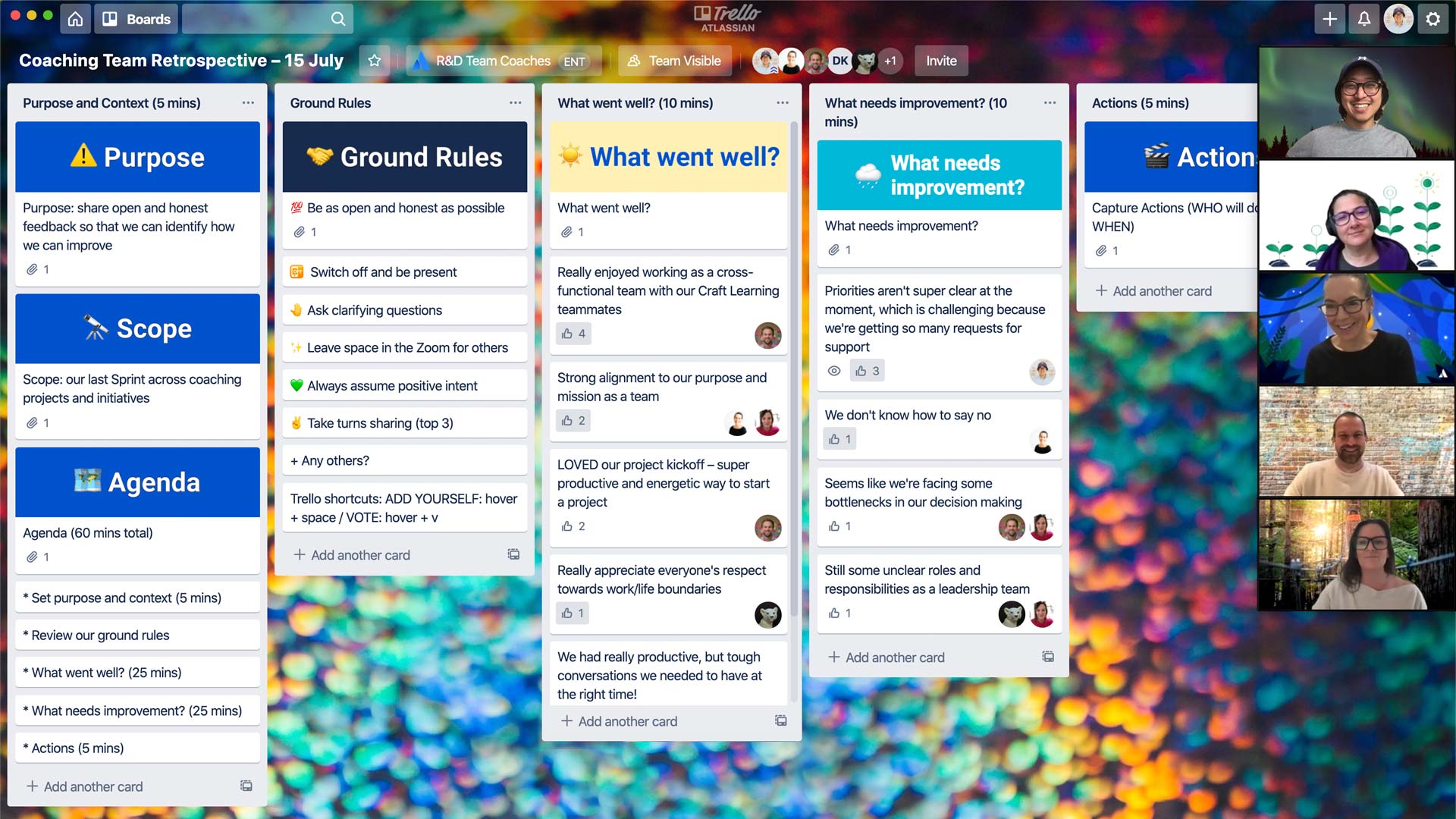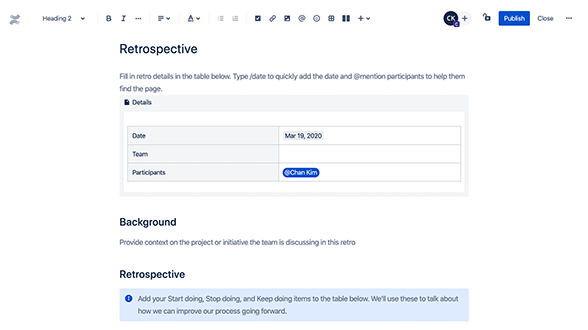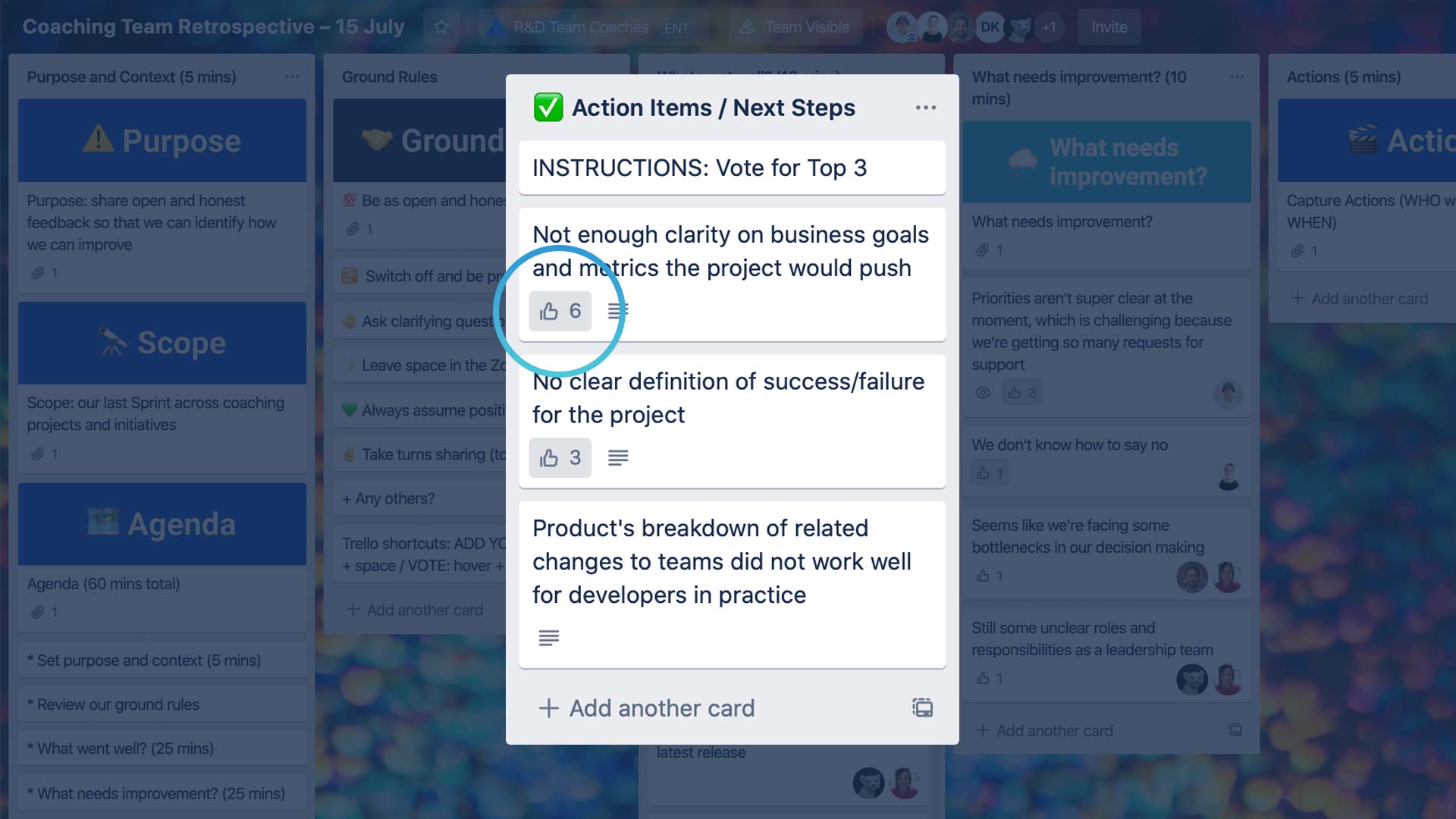Retrospectivas do sprint
Uma retrospectiva do sprint oferece a oportunidade de revisar o sprint mais recente e fazer melhorias nos futuros. Essas reuniões são essenciais porque avaliar e melhorar processos com frequência gera resultados de qualidade e reduz obstáculos.
Neste guia, a gente vai falar sobre o que é uma retrospectiva do sprint, por que ela é importante e como você pode conduzir revisões de sprint para tornar a equipe mais eficiente.
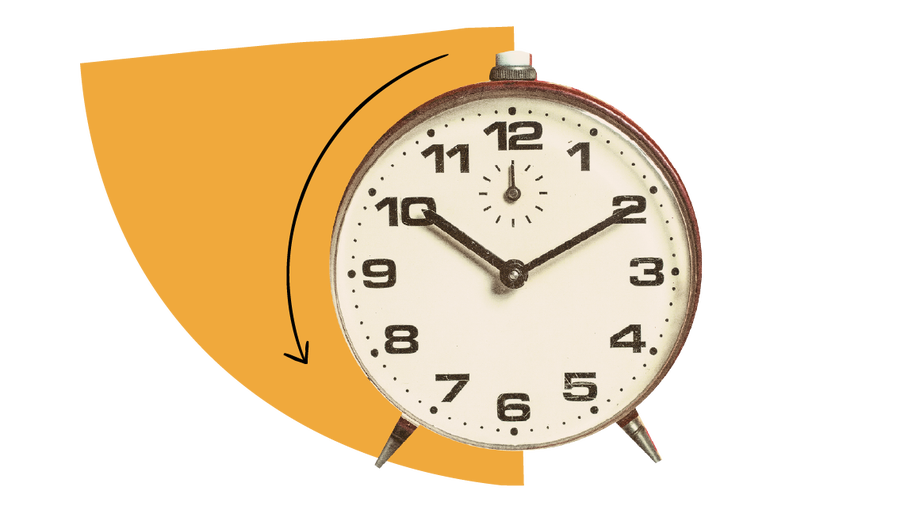
Tempo de preparo
15 min
Tempo de execução
60 min
Pessoas
4 a 8
RESUMO DE CINCO SEGUNDOS
- Comemore o que deu certo no último sprint.
- Discuta o que não foi tão bem ou poderia ter sido melhor.
- Determine que melhorias devem ser feitas no próximo sprint.
- Use a IA para resumir insights, gerar conclusões e facilitar a ação.
VOCÊ VAI PRECISAR DE:
- Espaço de reunião ou videoconferência com compartilhamento de tela.
- Ferramenta de colaboração digital (confira os templates).
- Opcional: quadro branco físico, canetinhas, notas adesivas e temporizador.
Como fazer uma retrospectiva do sprint
Reflita sobre os sprints anteriores para fazer melhorias no futuro.
O que é uma reunião de retrospectiva do sprint?
Uma retrospectiva do sprint é uma revisão feita após um sprint que desempenha um papel fundamental na metodologia ágil. A retrospectiva visa a determinar o que correu bem e onde aconteceram problemas, bem como a identificar áreas em que você pode melhorar.
As avaliações regulares são uma parte essencial da colaboração em equipe. Ao entender o que funciona e o que não funciona, você pode melhorar os processos ágeis para simplificar o próximo sprint.
E com a IA ajudando você a encontrar a documentação do sprint, resumir as conclusões e gerar etapas acionáveis, as retrospectivas do sprint são ainda mais valiosas.
Quem deve participar de uma reunião de retrospectiva do sprint?
A reunião de retrospectiva do sprint deve incluir o proprietário do produto, a equipe de Scrum, o Scrum Master, as partes interessadas e o Rovo.
Durante uma reunião de retrospectiva do sprint, é bom ter diversas perspectivas na sala. Todos podem trabalhar juntos para analisar o último sprint e determinar quais mudanças você precisa fazer antes de iniciar a próxima parte do projeto.
Com que frequência você deve fazer retrospectivas do sprint?
O melhor momento para fazer essas retrospectivas é ao final de cada sprint. Mas caso seus sprints sejam curtos (como de uma semana, por exemplo), talvez faça mais sentido conduzir as retrospectivas em sprints alternados.
Quanto tempo as retrospectivas do sprint devem durar?
A duração de uma reunião de retrospectiva do sprint pode variar dependendo de quanto tempo levou o sprint. Elas podem ser reuniões curtas de 45 minutos ou longas de até três horas. Dê à sua equipe tempo e espaço suficientes para uma conversa produtiva. Investir um tempo a mais no começo ajuda a poupar tempo e melhorar os resultados no longo prazo.
Quais são os principais benefícios das retrospectivas do sprint?
A retrospectiva do sprint é útil para sua equipe aprender com o que foi feito antes e melhorar no futuro. Essa prática leva à otimização dos sprints de Scrum e a um melhor resultado final.
Uma pesquisa mostrou que os principais benefícios das retrospectivas são que eles ajudam as equipes a:
- Alcançar uma melhoria contínua
Criar um plano de ação e seguir esse plano nas reuniões futuras é fundamental para o crescimento. - Melhorar a reflexividade do grupo
Reflexividade é definida como "o grau em que os membros refletem em conjunto sobre os objetivos, as estratégias e os processos da equipe e os adaptam às circunstâncias atuais ou previstas".
Equipes com níveis mais altos de reflexividade têm mais chances de serem melhores em inovar, identificar problemas e oportunidades, se adaptar às mudanças e implementar novas ideias com eficácia.
Existe uma correlação entre uma maior reflexividade e:
- Melhor tomada de decisão
- Melhor solução de problemas
- Mais eficácia na implementação de estratégias
- Maior aprendizado da equipe
- Mais inovação
-
Mais adaptabilidade às mudanças
Outra pesquisa reforça que a reflexividade ajuda a equipe a:
- Processar informações de forma mais completa.
- Reduzir os erros e as falhas.
- Ser mais ágil e flexível quando ocorrem mudanças.
Ideias para reuniões de Retrospectiva do sprint
As Retrospectivas do sprint podem parecer complexas no início, mas o conceito é bastante simples. Você pode usar o template de Retrospectiva do sprint ou seguir as cinco etapas listadas neste guia. Se está coletando feedback para gerar insights e implementar alterações, você está no caminho certo.
Cada Retrospectiva começa no sprint que teve êxito. O Jira oferece várias funções importantes para organizar sprints, incluindo:
- Backlogs: eles permitem que você liste todo o trabalho relacionado ao projeto ou iniciativa. Você pode dividir esse trabalho em sprints individuais, os quais duram, em geral, duas semanas.
- Quadros: os quadros do Jira dividem projetos grandes em partes menores e mais gerenciáveis. Assim, você pode planejar os sprints e garantir que a entrega dos resultados seja mais rápida.
- Cronogramas: eles mantêm a equipe sincronizada com as partes interessadas por meio da visão geral do cronograma do projeto, que tem itens de trabalho, dependências e lançamentos mapeados.
O Jira facilita a visualização, o acompanhamento e o gerenciamento dos sprints para as equipes ágeis. Com o Jira, você agiliza o próximo sprint para garantir entregas no prazo. Teste os quadros do Jira Scrum e veja como o Jira otimiza a equipe ágil.
Perguntas frequentes sobre a retrospectiva do sprint
1. Defina o tom
Tempo estimado: 5 min
As retrospectivas são parte do processo de planejamento de sprint. O objetivo é coletar feedback e perspectivas variadas para melhorar os processos e os resultados. Use um dos nossos templates prontos para facilitar o processo.
No início da reunião, incentive as pessoas a compartilharem os próprios pensamentos com respeito, liberdade e honestidade durante a sessão, com foco na melhoria e não na culpa. Esse incentivo é fundamental para dar segurança psicológica e criar uma cultura sem culpabilização. Para ajudar, adicione o Loom AI na sua reunião a fim de reunir notas para que sua equipe possa se concentrar na retrospectiva.
Por fim, incentive sua equipe a conversar com o Rovo como parceira de ideias se ela tiver alguma dúvida sobre o tom ou a mensagem de feedback.
Dica: crie espaços seguros
Deixe claro o que vai acontecer com as informações discutidas durante a retrospectiva. Só o grupo terá conhecimento delas? Elas serão compartilhadas com a liderança? Considere adotar a Regra da Chatham House para fazer os membros da equipe se sentirem mais seguros e confortáveis.
2. Colete o feedback
Tempo estimado: 15 min
Após definir o tom e as expectativas para a reunião, você pode coletar o feedback dos membros da equipe sobre o último sprint. Há muitas maneiras de fazer isso, incluindo:
- 💬 Discussão aberta em grupo sobre o que foi bom ou não.
- 🗒️ Pesquisas anônimas ou identificadas.
- ❤️ Retrospectiva dos 4 Ls: discuta o que todos amaram, odiaram, aprenderam e ansiaram no último sprint.
- 🙂 Estrutura "tristeza, raiva e felicidade": discuta o que fez os membros da equipe sentirem cada uma dessas emoções. O que foi decepcionante, frustrante, empolgante e encorajador?
- Use a Pesquisa Rovo para reunir páginas ou tickets relevantes para ajudar a contextualizar o feedback.
Dica: incentive as pessoas a falarem
Um dos maiores obstáculos na retrospectiva do sprint é quando os membros da equipe não compartilham feedback suficiente. Além de criar um espaço seguro, tente guiar a conversa com esquema simples, como a Retrospectiva dos 4 Ls ou a estrutura de "tristeza, raiva e felicidade". Você também pode tentar coletar feedback anônimo.
Se alguém estiver dominando a conversa, pergunte a opinião de outras pessoas para que todo mundo seja ouvido.
3. Transforme o feedback em insights
Tempo estimado: 20 MINUTOS
Em grupo, procure padrões e tendências no feedback. O que a gente aprendeu? Que mudanças podemos fazer para aproveitar as coisas boas e minimizar ou evitar o que foi ruim? Esses insights são fundamentais para definir as metas e fazer as melhorias. Por isso, incentive todo mundo a contribuir como puder.
Dica: procure identificar as tendências
O objetivo dessas retrospectivas é melhorar o sprint seguinte. Por isso, concentre sua atenção na identificação de padrões e tendências, em vez de perder tempo com erros ou sucessos pontuais que têm poucas chances de se repetirem.
Dica: inclua o Rovo no grupo
Use o Chat Rovo para transformar o feedback nos principais padrões e tendências.
4. Crie itens de ação
Tempo estimado: 15 min
Agora é hora de agir com base nos insights. Neste ponto, você pode começar a definir as metas e determinar quais alterações devem ser feitas nos próximos sprints.
Ao documentar essas alterações e itens de ação, não se esqueça de atribuir proprietários e prazos para dar início ao progresso.
Dica: adicione os itens de ação à sua lista de tarefas
Em vez de (ou além de) escrever os itens de ação em uma nota adesiva ou documento digital, os adicione no próprio planejamento de sprint ou sistema de gerenciamento de projetos, como o Jira ou o Trello. Assim eles já ficam incorporados aos seus planos.
Se um dos itens de ação tiver um ticket correspondente, inclua os links na página e/ou tarefas da retrospectiva para conferir o status com mais facilidade.
Dica: use o Chat AI
Transforme o feedback, os padrões e os insights nas próximas etapas práticas com o Chat AI.
5. Conclusão
Tempo estimado: 5 min
Para encerrar a retrospectiva do sprint, agradeça a contribuição de todos e compartilhe um resumo dos principais aprendizados e itens de ação. Depois é só partir para o próximo sprint!
Variações
Não deixe que suas retrospectivas se tornem uma mera obrigação "para cumprir tabela", sem servir para nada. Há várias maneiras de incentivar a conversa. Faça alguns experimentos e descubra o que funciona melhor com seu grupo. Aqui estão nove dos exercícios de retrospectiva do sprint que a gente mais gosta.

Ainda tem dúvidas?
Inicie conversas com outros usuários do Esquema Tático da Atlassian, receba suporte ou forneça feedback.
Outras táticas que você pode gostar
Reuniões
Atualizações semanais da equipe
Compartilhe como tudo está indo sem agendar outra reunião.
Reuniões
Reuniões baseadas em página
As melhores reuniões começam com uma página que descreve o propósito, os resultados esperados e os principais pontos de discussão.
Comunicação
Guia de usuário
Ajude seus colegas de equipe a entender como trabalhar melhor com você.
Cultura
Monitor de Saúde da equipe
Avalie a saúde da sua equipe e determine um plano de melhoria.
Mantenha-se atualizado
Receba as últimas dicas sobre táticas e vida profissional ao se inscrever em nossa newsletter.







